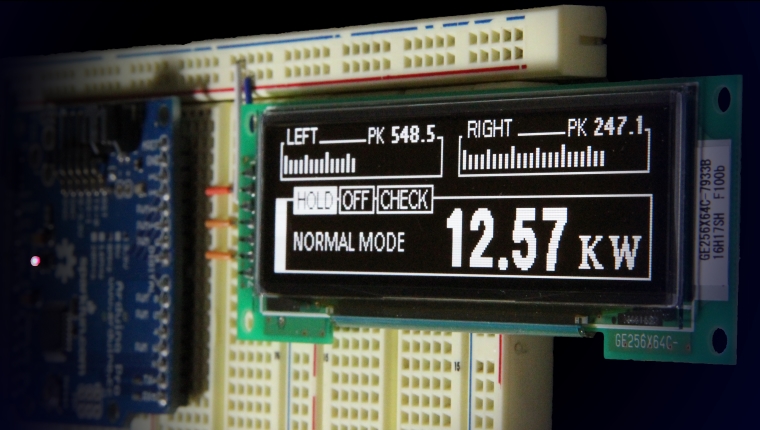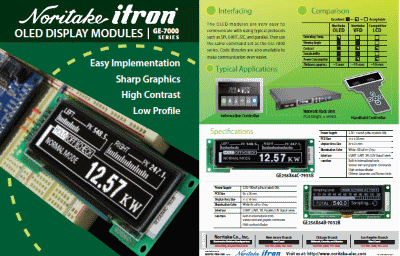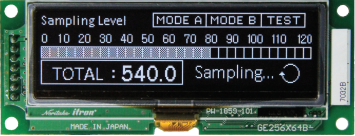-

GE256X64C-7933B
-
OLED Display Module
GE-7000 SeriesEffortless MCU
Interfacing
Features
OLED Demonstration Video
Simple Interfacing
 Available with industrial standard serial interfaces (UART/USART/SPI) to directly connect the display to an MCU.
Available with industrial standard serial interfaces (UART/USART/SPI) to directly connect the display to an MCU.
OLED Module
High-performance intelligent design includes all the necessary circuitry to drive the OLED panel with a single 3.3V power source.
Crisp Image
- High contrast black and white display
- High density (≈ 0.3mm dot pitch)
- Wide viewing angle
Wide Operating Temperature
The module works with a wide ambient temperature range;
- GE256X64C-7933B: -20 to +70 °C
- GE256X64B-7032B: -30 to +75 °C
Low Profile
The module’s PCB is designed to be low profile and can fit in a narrow enclosure like a handheld console or a 1U rack application.
Dependable
- Reliable COG OLED panel construction
- Long life, high quality
Useful Functions
Simple Commands
Command-based controls are easily driven by off-the-shelf MCUs. After the module is powered, you can immediately start sending character code commands.
| Command | Hex Code |
| Character Display | 0x20 to 0xFF |
| Backspace | 0x08 |
| Horizontal Tab | 0x09 |
| Line Feed | 0x0A |
| Home Position | 0x0B |
| Carriage Return | 0x0D |
| Display Clear | 0x0C |
| Initialize Display | 0x1B, 0x40 |
More useful commands can be seen in the module’s respective specification.
Built-in Fonts
GE-7000 modules come standard with both bitmap and ASCII fonts, along with font tables that include European language fonts. You can also register your own font.

Memory for Image Data
The GE256X64C-7933B has 512KB of FROM to save image data, which is comparable to 256 screens.

Product
GE-7000 Series | Noritake OLED Display Module
-
The GE-7000 series OLED modules are high performance and intelligent displays that provide effortless MCU interfacing by using industrial standard serial interfaces (UART/USART/SPI). Various text and graphic commands are included to reduce development cost, along with many built-in international fonts that can be displayed with single-byte ASCII code. Code Library and evaluation tool are available on our website.
-
GE256X64C-7933B
This OLED display has the same footprint as a 20×2 character LCD. This replacement becomes an upgrade because of the built-in 512KB flash-ROM and easy-to-display international character font tables (including CJK Kanji).
-
GE256X64B-7032B
This compact OLED display is equipped with standard serial interfaces as well as 8-bit parallel to communicate with a wide range of microprocessors. It also has a high density 256×64 dot matrix display that can handle up to 8 lines of characters.
Specification
| Module Part Number | GE256X64C-7933B | GE256X64B-7032B |
|---|---|---|
| Display area | 87.5 x 21.3 mm | 71.4 x 19.0 mm |
| Outline Size | 115.0 x 36.0 x 8.2 mm | 94.0 x 36.0 x 8.2 mm |
| Display Resolution | 256 x 64 dots | 256 x 64 dots |
| Dot Pitch | 0.342 x 0.333 mm | 0.28 x 0.3 mm |
| Color of illumination | White | White |
| Operating / Storage Temperature |
-20 to +70 °C / -30 to +80 °C |
-30 to +75 °C / -40 to +85 °C |
| Brightness |
Min. 70 cd/m² |
Min. 68 cd/m² |
| Operating Power (Typical) |
3.3V / 270mA (All dots on) |
3.3V / 220mA (All dots on) |
| Interfaces | Serial interface (UART/ USART/ SPI) |
Serial interface (UART/ USART/ SPI) + 8 bit parallel |
| Character Fonts | ASCII + Kanji (Chinese, Japanese and Korean) |
ASCII |
Block Diagram
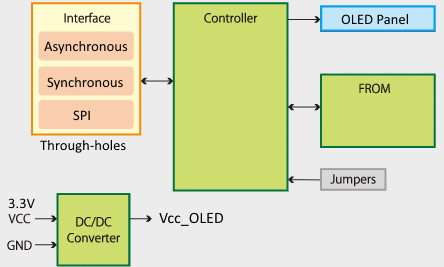
What is OLED?
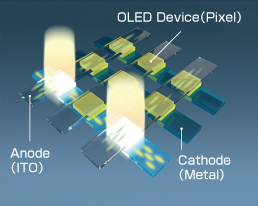
OLED displays are a new-generation technology utilizing organic compounds with self-emissive characteristics. OLED displays produce higher contrast images, have a wider viewing angle, faster response, and are thinner and more lightweight compared to conventional displays.
Working Principle of OLED
OLED modules have a simple structure with an organic light emitting layer between anodes and cathodes. When a direct current is applied to the device, anodes inject holes with positive charges and cathodes inject electrons with negative charges into the light emitting layer. Then, the organic molecules emit light when the positive hole and the negative electron couple and generate energy in the organic light emitting layer. Because most of the organic materials are insulators and do not easily conduct current, the organic light emitting layers need to be very thin (approximately 0.1µm).
Device Structure of OLED
The typical device structure of OLED is a laminated anode (transparent electrode), a hole injection layer, a hole transport layer, an emitting layer, an electron transport layer, an electron injection layer, and a cathode (metal electrode) on the glass substrate. Each layer is stacked on the glass substrate using vacuum deposition technology. Because organic materials are affected by oxygen and moisture, OLED panels are encapsulated by sealing materials such as metal or glass after being produced into layers on the glass substrate.
Development Support
Value Added Services
Optimize your manufacturing process by letting us take care of your connector, cable, conformal coating, filter, and control board needs.
Global Customer Support
Your needs are locally supported. Our sales offices are located worldwide and committed to providing guidance, tools, and technical resources directly to you.
Download Specification
Check out the list of specifications attributed to the GE-7000 modules on their respective product pages. Display commands, electrical requirements, and measurements can be found in the module specific datasheet. Compatible font table specifications are also listed for your convenience.
NOTE: You must register with Noritake before downloading.
Code Library
Quickly begin programming your own GE-7000 module application using an ATMEL ATMEGA MCU with our code library.
An Arduino code library is also available. This guide describes how to install the library and use the “Hello” example program.
Software Development Support Tool
We offer three Windows© based tools to support your software development. GUD-10K is command evaluation software which gives you GUI to execute many GE-7000 commands by 1 click.

